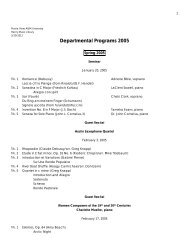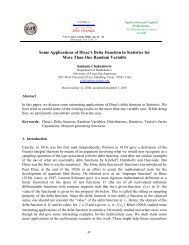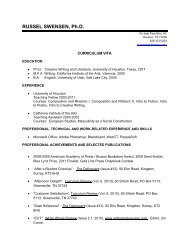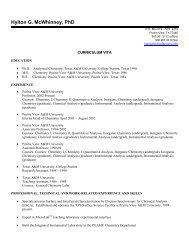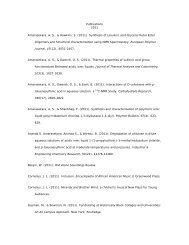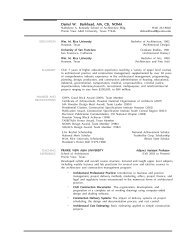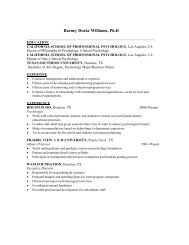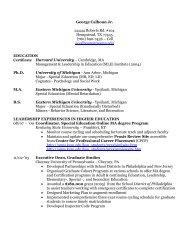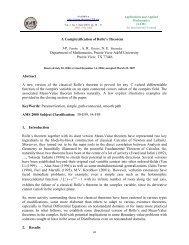j o u r n a l o f h i s t o r y a n d c u l t u r e END NOT ES 1. Ronnie C. Tyler <strong>and</strong> Lawrence R. Murphy, The Slave Narratives <strong>of</strong> Texas (Austin, TX: The Encino Press, 1974). 2. Mary McAllister Ingram , Canebrake Settlements: Colonists, Plantations, Churches 1822-1870, Matagorda County, Texas, A Study <strong>of</strong> Plantations on Caney Creek: Inception <strong>of</strong> African American Settlements (Bay City, TX: Lyle Printing, 2006). 3. Ibid. 4. Ingram, Canebrake Settlements; Andrew Waters, I Was Born in Slavery: Personal Accounts <strong>of</strong> Slavery in Texas (Winston-Salem, NC: John F. Blair, 2003). 5. Marcus Freeman, Taxes <strong>and</strong> slavery in Texas, 1845-1860 (Prairie View A&M, 1956) 38; Elizabeth Silverthorne, Plantation Life in Houston (College Station, TX: Texas A&M University Press, 1986) 167. 6. Waters, I Was Born in Slavery, 6. 7. Ibid. 6. 8. Ibid. 14 9. Ibid. 45 10. Ibid. 50 11. T. Lindsay Baker <strong>and</strong> Julie P. Baker, Till Freedom Cried Out: Memories <strong>of</strong> Texas Slave Life (College Station, TX: Texas A&M University Press, 1997) 85. 12. Carrie B. Coss, Historic Homes, Liendo Planataion (Waller County Historical Commission, Series No. III, 1977). 13. H. W. Br<strong>and</strong>s, Lone Star Nation (New York: Double Day, 2004) 149; William Davis, Lone Star Rising (New York: Free Press, 2004) 60; Andreas Reichstein, Rise <strong>of</strong> the Lone Star (College Station, TX: Texas A&M University Press, 1984) 79-80; see also Coss, Waller County. 14. Coss, Waller County 15. Ibid. 16. Ibid. 17. The historical marker at Wyatt Chapel Cemetery indicates that Jared Kirby is a cousin to Leonard Groce; see Coss, Waller County for dates. 18. Charles C. Jackson, “Kirby, Jared E.” H<strong>and</strong>book <strong>of</strong> Texas Online. Electronic document, http://www.tshaonline.org/h<strong>and</strong>book/online/articles/KK/fki44.html, accessed March 19, 2009. 19. George R. Woolfolk, “Alta Vista: Monument <strong>of</strong> Sorrow,” One Hundred One Heritage Homes <strong>of</strong> Waller County, Texas (Hempstead, TX: Waller County Historical Society, 1976). 20. William Reed, “Prairie View, Texas”. H<strong>and</strong>book <strong>of</strong> Texas Online. Electronic documents, http://www.tshaonline.org/h<strong>and</strong>book/online/articles/PP/hgp12.html, accessed March 19, 2009. 21. This information is contained in a h<strong>and</strong>written note by an unknown author who indicated that she was a student at Prairie View A&M University in the early 1930s. The note is part <strong>of</strong> an informal collection <strong>of</strong> documents assembled into a binder by university personnel. 22. Signed statement from an interview with Mrs. Carrie Bell Coss, long time resident <strong>of</strong> Prairie View, TX, <strong>and</strong> retired pr<strong>of</strong>essor from Prairie View A&M University, September 18, 1989. Accompanying signed note by Mildred W. Abshier. Notes are part <strong>of</strong> Prairie View A&M informal collection. 23. <strong>History</strong> <strong>of</strong> Wyatt Chapel Baptist Church, author unknown, part <strong>of</strong> Prairie View A&M informal collection. 24. Ada L. (Tompkins) Bennett, Family <strong>History</strong> <strong>of</strong> Dick <strong>and</strong> Lucinda (Wyatt) Richards <strong>of</strong> Waller County (Prairie View A&M informal collection, 1995); Texas State Library <strong>and</strong> Archives Commission, Electronic document, http://www.tsl.state.tx.us/exhibits/forever/biographies/page11.html, accessed March 19, 2009. 25. Paul M. Lucko, “Wyatt, George W.” H<strong>and</strong>book <strong>of</strong> Texas Online. Electronic document, http://www.tshaonline.org/h<strong>and</strong>book/online/articles/PP/hgp12.html, accessed March 19, 2009. 26. Bennett, Family <strong>History</strong> <strong>of</strong> Dick <strong>and</strong> Lucinda (Wyatt) Richards . 27. Mildred W. Abshier, Wyatt Chapel Community Cemetery (Prairie View A&M informal collection, 1989). 28. Bennett, Family <strong>History</strong>. 29. Photographs with captions in Prairie View A&M informal collection. 30. R. W. Jamieson, “Material <strong>Culture</strong> <strong>and</strong> Social Death: African American Burial Practices,” Historical Archeology, 29(4), 1995:39-58. 31. These dates are based upon unpublished research in 2006 by author (Henning). 32. These dates are based upon unpublished research in 2007 by author (Henning) at these two cemeteries. 33. Texas Historical Commission, Developing a Master Preservation Plan for a Historic Cemetery, 2003, available online at http://www.thc.state.tx.us/forms/cemeteries/ CemMasterPlan.pdf 34. Carl J. Pierce, “Forensic ground penetrating radar for the improved management <strong>of</strong> cemeteries <strong>and</strong> gravesites, Texas USA,” Geological Society <strong>of</strong> America Abstracts with Programs, 37(7), 2005. 35. R. F. I. Solis, “Upper Tertiary <strong>and</strong> Quaternary depositional systems, central coastal plain, Texas—Regional geology <strong>of</strong> the coastal aquifer <strong>and</strong> potential liquidwaste repositories,” The University <strong>of</strong> Texas at Austin, Bureau <strong>of</strong> Economic Geology Report <strong>of</strong> Investigations 108, 89 p. 36. Lawrence B. Conyers, Ground Penetrating Radar for Archeology (California: Altimira Press, 2004); H. Lorenzo <strong>and</strong> P. Arias, “A Methodology for Rapid Archeological Site Documentation Using Ground-Penetrating Radar <strong>and</strong> Terrestrial Photogrammetry,” Geoarcheology, 20(5), 2005:521-535. 37. Jamieson, Material <strong>Culture</strong>. 38. A. M. Abbas, T. F. Abdallatif, F. A. Shaaban, A. Salem, <strong>and</strong> M. Suh, “Archeological Investigation <strong>of</strong> the Eastern Extensions <strong>of</strong> the Karnak Temple Using Ground- Penetrating Radar <strong>and</strong> Magnetic Tools,” Geoarcheology, 20(5), 2005:537-554. 39. Conyers, Ground Penetrating Radar. 40. Abshier, Wyatt Chapel Community Cemetery. 66
HUMAN ACTIVITY AND SYMBOLIC STRUCTURES A Qualitative Study <strong>of</strong> People’s Experiences <strong>and</strong> Activities at the Bonfire Memorial ARSENIO T. RODRIGUES, PH.D. Abstract The purpose <strong>of</strong> this study was to explore the deeper meaning <strong>of</strong> visitor’s experiences <strong>and</strong> activities within structures <strong>of</strong> symbolic <strong>and</strong> cultural significance. The Bonfire Memorial at Texas A&M University was chosen as the setting for this study. Direct observations, kinesics, proxemics, <strong>and</strong> photography were used as methods to determine how people interacted with the physical characteristics <strong>of</strong> the Bonfire Memorial. Phenomenological interviews were conducted at the Memorial to determine ‘personal’ experiences <strong>of</strong> the physical characteristics <strong>of</strong> the Memorial, <strong>and</strong> to determine the chronology <strong>of</strong> peoples’ experiences within the setting. A total <strong>of</strong> six observations <strong>and</strong> six interviews were conducted at the Memorial. The study concluded that Bonfire Memorial was associated with (among other experiences) the ‘memory <strong>of</strong> Bonfire Ceremony’, ‘tradition’, ‘history’, ‘pride’, <strong>and</strong> ‘sadness’. People appreciated the Memorial <strong>and</strong> thought <strong>of</strong> it as a ‘wholesome’ <strong>and</strong> ‘unified’ place. In addition, the Memorial was appreciated for being a contemplative setting to reflect on one’s own life. Introduction The Bonfire Memorial is dedicated in remembrance <strong>of</strong> 12 Aggies who lost their lives, including 27 Aggies who sustained injuries when the bonfire tragically collapsed on November 18, 1999. The Memorial is made up <strong>of</strong> 3 distinct spaces – Tradition Plaza, <strong>History</strong> Walk, <strong>and</strong> Spirit Ring <strong>and</strong> is widely visited by students, staff, faculty, visitors <strong>and</strong> other members <strong>of</strong> the community, interested in its traditional, solemn, <strong>and</strong> monumental significance. The underlying objectives <strong>of</strong> the research were: 1) To determine how people interact with the physical characteristics <strong>of</strong> the Bonfire Memorial; 2) To determine peoples’ experiences <strong>of</strong> these physical characteristics; <strong>and</strong> 3) To determine the chronology <strong>of</strong> peoples’ experiences within the setting. Qualitative research methods proved to be advantageous for the research, since spatial <strong>and</strong> social interactions <strong>of</strong> participants are crucial to the study <strong>of</strong> experiences that a particular place can evoke. Through qualitative research methods, the study <strong>of</strong> social interactions can prove fruitful to underst<strong>and</strong> the socio/cultural aspects <strong>of</strong> the participant’s daily lives 1 . Multiple qualitative research methods (mixed methods) were utilized in this study. Mixed research methods are increasingly gaining favor as an alternative to the exclusive use <strong>of</strong> a single method, particularly when addressing multi-faceted research problems 2 . 67





